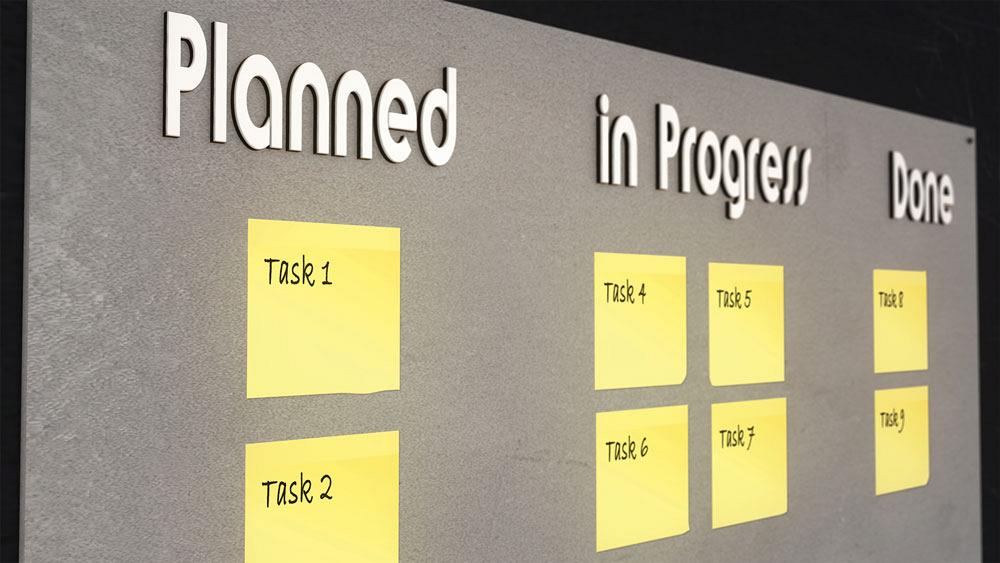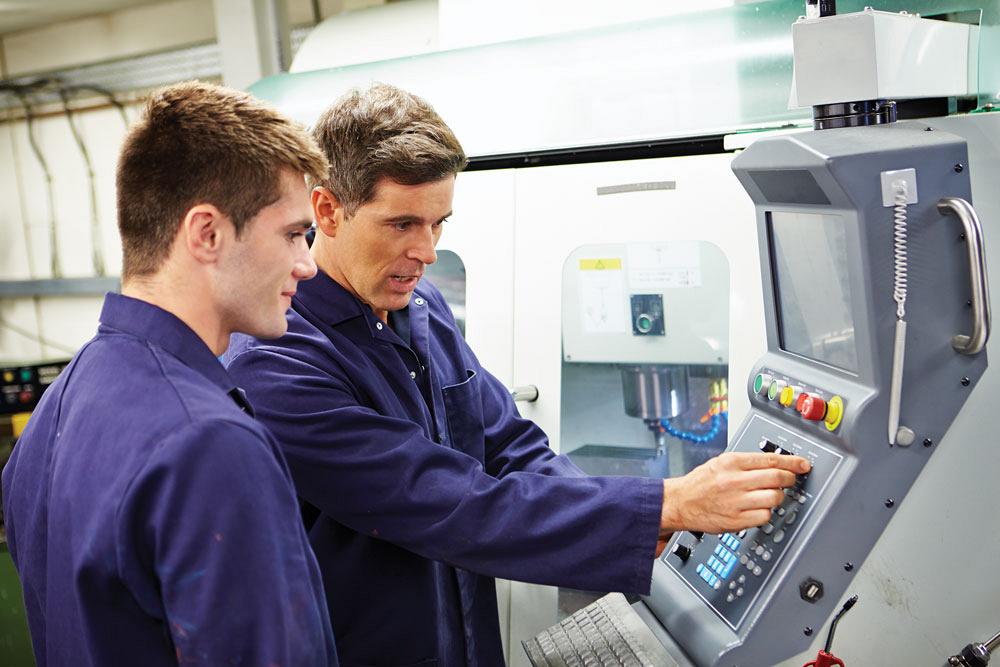Associate Editor
- FMA
- The Fabricator
- FABTECH
- Canadian Metalworking
Break apart to make better
The best way for any shop to explore kaizen is to look at its most critical process
- By Lindsay Luminoso
- March 1, 2021
- Article
- Management

Shops need to look at the critical process and map it out or develop what’s called a current value stream.
Implementing kaizen is all about organizational transformation. But what exactly does that mean? It’s not about ensuring a project runs smoothly or simply eliminating waste during events. Instead, kaizen needs to be used to help transform an organization or shop holistically—all aspects of the organization need to be included. It’s not just process improvement and transforming wasteful and inefficient processes into more finely tuned options. It’s also about transforming the leadership structure, support structure, meeting structure, and how people interact daily. The goal of kaizen is to create a full culture of continuous improvement throughout all areas of an organization.
For the most part, a shop’s primary focus is on expanding, getting orders out, and making sure that they can keep up with demand. There is rarely any time to look at the process itself because everyone is so focused on other things. Many shops just live with ineffective and inefficient processes and focus on fires as they occur. This isn’t a great way to operate; shops need to implement a more proactive and preventive approach.
"It’s important to focus in on the process because the process is key to everything," said Mike Micklewright, senior director, Kaizen Institute United States, Chicago, Ill. "It’s the key to making money."
The best way for any shop to explore kaizen is to look at its most critical process. What is the most critical process? Where is most of the money made? What is that process that adds value to products? Where are the biggest gains or opportunities?
"Shops need to look at the critical process and map it out or develop what we call a current value stream," said Micklewright. "To develop a current value stream, a shop needs to develop a multifunctional group and walk through its processes. It’s also good practice to have a facilitator who can be objective."
A multifunctional group is necessary so that everyone can see and understand the entire process, not just their individual segments. People rarely get this holistic view Once this is done, the team then can map the process out together, recording all steps and necessary data. It’s important to include the quality of output of each step, cycle time, wait time, lead time, and inventory buildup.
"Once the team collects data at each step, they can include it on the map with Post-it notes or visual representation," said Micklewright. "The value map should be placed on the wall where everyone can see it and should show waste in the process. The map will show the buildup of inventory, the waiting time, the overproduction, all of which is considered waste. It will also show the defects in the process. Being able to identify this waste is an important skill, but so is finding ways to reduce the waste."
This is where tools like 5S, total productive maintenance (TPM), supermarkets (storage locations of parts, managed by predetermined maximum and minimum inventory levels, before they go on to the next operation), and kanban (a method to deliver material or product to a succeeding process exactly when it is required) systems come into play. These tools will help reduce waste and make processes much smarter.
Once the value map is put in place, it’s important to look ahead by mapping out the future state in what Micklewright refers to as a value stream design, or VSD. Once this is done, a deployment plan should be created to put goals into action. This deployment plan can be a few short weeks to several years, depending on the scope of the project. It’s all about solving real problems and making daily improvements to meet goals and achieve that bigger-picture approach.
Break Apart
Kaizen means to change for the better. But many shops don’t think they can take the time to implement process changes. They are too focused on making good parts and getting them out the door to customers.

Kaizen is all about visual management. By using a white board or something similar on a production floor with data attached about how the shop is operating day to day, hour by hour, everyone in the shop can see where corrective action is needed.
"I think it’s important to remember that kaizen is all about breaking apart to make better," said Micklewright. "COVID-19 has broken apart many processes already. It is a different kind of breaking; it’s more about survival for many shops. But for some, the slowdown in production might be an opportunity to look at new processes or upgrading old practices."
The pandemic has changed many traditional ways of doing things. More people are working from home, and manufacturing facilities must adjust to social distancing and safety measures. In many ways, they are already implementing some 5S practices by adhering to strict guidelines. They’ve also adopted different software and communication platforms to make it easier to connect.
"With kaizen it’s all about visual management," said Micklewright. "If you can envision a white board on a production floor with data attached about how the shop is operating day to day, hour by hour, that’s how shops can see where corrective action is needed. Well, if all members of the shop are not actually on the shop floor or centralized to the one location, then how can they take advantage of the white board? In this COVID world, we are seeing opportunities to make these things more accessible."
In some instances, it’s expanded the possibilities of improvement because existing processes have already been significantly disrupted or upset because of the demands of the pandemic.
"Look at how many people have gotten better at 5S because of COVID," he said. "Shops are implementing systems because they have to and can take these best practices forward for continuous process improvement."
Continuous Improvement
The first thing that comes to many people’s minds when they think of kaizen is project work or an event. And if they use it for a project, they automatically think of themselves as a lean organization.
"This is where shops will see big payback, but none of that will work unless they have processes in place to sustain it and continue to make small incremental improvements," said Micklewright. "Doing a kaizen project once a month is more like continual improvement rather than continuous improvement. Instead of periodic improvement, we want to see improvement every day. I think that’s one of the big misconceptions. Shops need to start building in the daily kaizen approach rather than just a sole focus on a project-based approach."
Every shop has a natural team; for instance, in a machine shop a natural team may be the milling operators. And within this team there is generally a team leader. In order to implement a daily kaizen approach, the natural team needs to look at how it interacts with one another, define the team leader’s role and responsibility, respond to problems immediately, and visually monitor the white board or scoreboard.
A team leader should be constantly improving the process, not necessarily performing machining tasks. A lot of team leaders revert to performing their daily tasks, often tasks they love, rather than overseeing the team. They need to lead and make improvements while the other team members take on the machining tasks.
A daily kaizen meeting or huddle meeting can help keep this in check. Everyone in the team will have access to and understand the workplace organization through the standards that are set out for process improvement. Many of the big improvements shops try to make often die out after a short period of time either because they aren’t sustainable or there is no accountability or actionable data supporting them. These improvements require changes in behaviours of leaders at all levels. A leader must focus on the process, which means he or she must be on the shop floor with people and see the process, question the process, and challenge the process to improve it.

Following TWI document format and job instruction processes will make it easier for shops to standardize training across all areas of the business.
Better Work Instruction
Another improvement can be developing a lean documentation system. Many companies have an excess of documents, an excess of information, and very un-user-friendly instructions, which can defeat the whole purpose of continual improvement.
"In both the ISO world and the lean or kaizen world, there is something called training within industry (TWI)," said Micklewright. "It was a service originating in the U.S. during the Second World War. The purpose was to help deliver defence products to the Allied forces. The government partnered with private industry, educational institutions, and unions. They developed this TWI service to improve the ability to effectively make high-quality defence products for the war."
Within TWI there are three sections: job relations (JR), job methods (JM), and job instructions (JI). JR is all about taking a people-centric approach to solving problems and building positive employee relations. JM relates to teaching team leaders and making processes better through continuous improvement. JI focuses on teaching team leaders how to effectively and respectfully train workers so that they know not only what to do, but also why each step is important.
"One way to really focus in JI is through a job breakdown sheet," said Micklewright. "It’s a standard document format that is both simple to write and simple to follow."
The document generally has three columns: major steps, key points, and reasons for key points. There is sometimes a fourth column for images.
The "major steps" column lists the process and identified big steps. The "key points" column relates to quality, safety, tips and tricks, and how to perform a step. And the third "reason for key points" column outlines the key points and explains the consequences of not performing certain steps.
"This is a great way to train employees," said Micklewright. "This format lays out a very brief summary. Having this type of document is just one part of the equation, though. The other half is following a respectful process to teach it to employees. We often throw too much information out at one time, which can be confusing. People learn best incrementally; finding a way to build on knowledge is important, and this document and process does that."
There are seven different iterations for the trainer to follow. Micklewright explained that a leader and employee stand together. The leader uses the first column of the document to perform the action, telling the employee what the steps are to follow. The second time, the leader goes through the first and second columns, stressing key points as the action is performed. The third time, the leader follows all three columns, stressing the main reasons for the key points while performing the action.
Then it’s the employee’s turn to perform the process. The fourth iteration has the employee simply perform the steps. In the fifth iteration, the employee performs the actions and states the major steps. The employee then focuses on the key points in the sixth iteration. In the seventh iteration, the employee explains why each step and key point is important.
"With these seven iterations, the leader does it three times and the employee does it four times," said Micklewright. "But it’s really just a respectful way of teaching and learning. It’s hands on, verbal, and visual instruction so that any type of learner can perform the steps well. Using this brief document ensures consistency across the company and its processes. Employees don’t just need to know what to do, but why to do it. And this allows for verification and understanding. It’s just a great tool to help improve processes."
Following this document format and job instruction process will make it easier for shops to standardize training across all areas of the business. It also creates an environment where companies can present clear and concise information in a respectful manner, which will benefit both management and workers.
Associate Editor Lindsay Luminoso can be reached at lluminoso@canadianmetalworking.com.
Kaizen Institute, www.kaizen.com
About the Author

Lindsay Luminoso
1154 Warden Avenue
Toronto, M1R 0A1 Canada
Lindsay Luminoso, associate editor, contributes to both Canadian Metalworking and Canadian Fabricating & Welding. She worked as an associate editor/web editor, at Canadian Metalworking from 2014-2016 and was most recently an associate editor at Design Engineering.
Luminoso has a bachelor of arts from Carleton University, a bachelor of education from Ottawa University, and a graduate certificate in book, magazine, and digital publishing from Centennial College.
subscribe now


Keep up to date with the latest news, events, and technology for all things metal from our pair of monthly magazines written specifically for Canadian manufacturers!
Start Your Free Subscription- Industry Events
MME Winnipeg
- April 30, 2024
- Winnipeg, ON Canada
CTMA Economic Uncertainty: Helping You Navigate Windsor Seminar
- April 30, 2024
- Windsor, ON Canada
CTMA Economic Uncertainty: Helping You Navigate Kitchener Seminar
- May 2, 2024
- Kitchener, ON Canada
Automate 2024
- May 6 - 9, 2024
- Chicago, IL
ANCA Open House
- May 7 - 8, 2024
- Wixom, MI




















